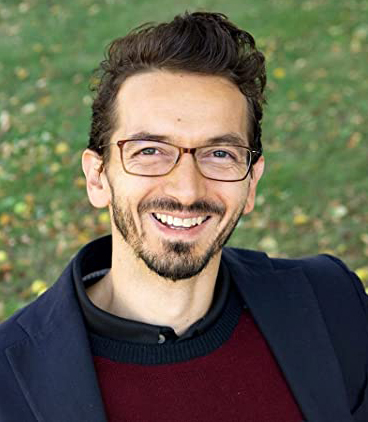N
I have no doubts most people would react to a text starting with a single letter (harf). Without any preface, it would be seen as an error, as something that was overlooked by the entire chain of author-editor-copyeditor. Or maybe it would be explained as a printing error. Yet, this is a rather typical way several of the Qur’anic surahs start, with one or several single letters which form no word whatsoever. They are called “huruf muqatta’at” (“disjoined letters” حُرُوف مُقَطَّعَات) and appear in combination from one to five at the beginning of twenty-nine surahs. [1]
Like loose drifting atoms that form no molecules, they not only assert themselves as integral parts of entire surahs but open them. No one really knows why The Qur’an contains these mysterious openings, and the most creative guesses such as Fakhr al-Din Al-Razi’s beautiful notion that they are like the icing on the cake, still feel like nothing but guesses. This does not mean they are random, that they do not belong to the entire structure, just there are elements of the exciting galaxies that astronomers cannot always fit into their macro view of the universe. These letters call the listener to attention, hooking the audience by pointing to the simple beginnings of life as well as the projected simplicity and singularity of death. They make us wonder about their place in the macrostructure of the book, the structure that most of us do not quite understand. The smallest and the biggest features of The Qur’an seem to remain out of reach.
I started small and went big, from micro to macro, using the opening letter the surah “Al-Qalam” (The Pen) which begins with the letter ن. I will later close-read this surah to try and explain a possible way of approaching a macro reading of The Qur’an. To do this, I will use recent images of galaxies made by the WEBB telescope, which created much wonder. Many people of faith found comfort in them. Muslims often shared them together with the third ayah from surah “Al-Mulk” (Power): “[And] who created seven heavens in layers. You do not see in the creation of the Most Merciful any inconsistency. So return [your] vision [to the sky]; do you see any breaks?” (ٱلَّذِى خَلَقَ سَبْعَ سَمَـٰوَٰتٍۢ طِبَاقًۭا مَّا تَرَىٰ فِى خَلْقِ ٱلرَّحْمَـٰنِ مِن تَفَـٰوُتٍۢ فَٱرْجِعِ ٱلْبَصَرَ هَلْ تَرَىٰ مِن فُطُورٍۢ)
(Sahih International, quran.com). This ayah is but one among frequent cosmological metaphors which pull our attention to both the details and the macro structures of the universe and thus entice people to think of God as the Creator. Flawlessness is always emphasized both with regard to the Creation and The Qur’an itself as the divine revelation. In other words, the audience of The Qur’an is encouraged to look for flaws, and look again, with a guarantee that no flaws would be found and that the one experiencing it would grow tired of this futile endeavour. Instead, one is encouraged to contemplate the macro and the micro levels. Let’s zoom in and zoom out on The Qur’an like the WEBB telescope does with the universe. But first I need to give us some (back)ground.
Approach and Background
This article is not about theology but about reading methods. My approach is not that of a scholar of tafsir (exegeses), though I will touch upon some content, but of a reader-writer-teacher. As such, even though my subject is the holy Islamic scripture, I want to say something general about reading. I believe that every book teaches us how to read it, even the worst books. Some do it by following well-known cultural conventions, and we tune in automatically. More creative works demand an effort to recognise their organising principles. This is why I, as a creative-writing teacher, tend to ask my students to consider what a particular story “wants to be” and not simply critique it on the basis of one’s preferences. One cannot critique the Arabic love poem ghazal for not being a Petrarchan sonnet. To improve a story by means of constructive criticism, one needs to consider its implied principles. This requires a form of openness that most of us are often unwilling to accept.
The wonder of The Qur’an tends to be highlighted, among other things, through the way it pays attention to the micro and macro levels of life, the way it moves between the particular and the whole, and the way it shifts scales and categories of discourse in just a few words. The Qur’an is equally appealing to an overthinker like me who wants to grasp the whole and those who are satisfied by a few concrete fragments.
We must ask: is The Qur’an a book? What does it mean to read it as a book? It surely refers to itself as a “book” (كتاب) but then the same word designates a wide variety of phenomena, many of which do not necessarily fit the typical association of a bound volume, a codex (mushaf in Arabic). If we simply say the “book” means the complete text, we are still going to have fixed ideas of what fits and what deviates from that model.
It would not be far-fetched to claim that our traditional approach to The Qur’an is in the vein of fragmentation, or the micro level of analysis. We hardly ever read it cover to cover except in terms of so-called hatam recitations, but that is not what I am after here. What I mean is that the meaning of The Qur’an, as well as most Islamic knowledge, is conveyed through fragments: ayahs or even fractions of ayahs. These fragments are like single trees which we then, with time, turn into the woods that we call our faith. This approach is not wrong per se. It has its pros and cons as any approach, and before I propose a model of the macro perspective, I want to reflect on the fragmentary reading.
Traditionally viewed, any segment of The Qur’an is still The Qur’an. The part contains the whole the way the whole contains the part in the metaphysical sense (Al-Razi, 21/68-69) This is because every surah and every ayah have the same, strong directionality: ihlas (divine singularity), taqwah (God consciousness), tawbah (repentance, turning). The first generation needed over twenty years to get the entire revelation. This does not mean that if they died before and never experienced the entire “book” they were missing a fragment of their faith. Also, fragmentation serves a very important pedagogical function of The Qur’an, that of dosage, that is the consideration of how much and what kinds of knowledge the general audience can take in and under how long a time something needs to be repeated for it to be digested (a practical fikh example would be the rules concerning alcohol). Fragmentation is, in other words, related to human evolution within the faith itself.
Fragmentation can be negative in the way we speak of reading out of context, both the context of the entire book and the historical context. This would be a greater problem if there was not a strong tradition of practice. Imam Malik is famous for trusting the way people embodied faith more than single transmissions of fragments of something the Prophet s.a.w.s may or may not have said (Dutton, 69). But tradition can also cause sedimentation and rigidity. A dynamic approach is always best, like the pulsation of the beating heart of faith. That is why the oral and written traditions work with such beautiful symmetry. The moment we give supremacy to either, as we often see in Western scholarly approaches, we start getting lost in the woods, seeing only just a lot of trees.[2]
So, fragments can be individual letters, words, ayahs, and surahs. To visualise it, we can use the metaphors of molecules, cells, organs, and the body. We can go quantum: quarks, subatomic particles, atoms, and matter. We can go Big Bang: planets and stars, solar systems, and galaxies.
A book typically has letters, words, sentences, and chapters. But a book is not the sum of those parts. “Book” implies a structure, a form of narrative, and a narrative consists of things like plot, characters, settings, temporality, imagery, rhythm, aesthetic features, etc. These fragments which constitute a narrative are not necessarily of the same category.
Narratives are like universes because they attempt to comprise all kinds of things on different planes of existence into a coherent, functioning whole. To see how a narrative works, we must decide how, with what instruments, and from what angle we are approaching it. This choice, just like the directing of the WEBB telescope at distant galaxies, determines what we will see and how we will see it. A single approach is never the only right approach.
The Qur’an is undoubtedly one of the most beautiful works in the history of humankind. We recognise its stunning character in so many ways, even if we only consume it in fragments. History records show that from the very first moment people heard recitations of The Qur’an they had visceral reactions to its content, its aesthetics, and its innate sense of freedom (Al-Razi, 2/7). Even the fiercest opponents of its message could not deny this. Its fragments always somehow suggest the whole and the whole always draws attention to the fluid play of fragmentation.
It would hardly be an exaggeration to argue that today the globally dominant way of understanding the concepts of “book” and “narrative” is quite rigid and its main features are in many ways Biblical. Take for instance the key element of temporality: even in non-linear narratives, we practically always have, or try to find, a sense of beginning-middle-end. Suppose a narrative plays with temporality to create confusion with respect to what scene/event occurs prior/simultaneously/post any other event. In that case, we recognise this as something odd and try to order things on a linear timeline. This is the temporal vector of our way of understanding and writing history, and it is our way of understanding ourselves. Similarly, in science, the universe began with the Big Bang and will end with the Big Crunch. In most religions, the world had the moment of creation and will end with its destruction. So, when we see the WEBB images of distant galaxies, we are watching objects 13.5 billion years old. I recently joked with my wife telling her that all I know is she was pretty a millisecond ago. She answered that sound travels slower than light; therefore, my words were old news to her, so she was unsure if I still thought she was pretty.
Temporality is one of the most important features of any narrative. It has to do with logic, causality, and sequencing. We generally assume a narrow idea that one sequence is causally connected to the next. Otherwise, it becomes very hard to read and understand. We usually wonder, when we meet something unconventional, what the point may be. To ask what in the world is the point with the “huruf muqatta’at” seems like looking at a few unrelated atoms and wondering why they even exist if they are not parts of some system.[3]
Reading The Qur’an as a whole seems to have always presented a difficulty to Western readers because they expect it to be a “book” in a conventional sense. Surahs are supposed to be chapters and ayahs verses. They expect the book to be a narrative that starts in the beginning and ends at the end, or at least that it is possible to order things chronologically. But The Qur’an does not allow for these conventions. It is literally full of all kinds of discourses, from stories (told in fragments over multiple surahs) to religious prescriptions, theological statements, cosmology, and much more (Hamza Andreas Tzortzis provides a nice summary of the great variation in Qur’anic poetics). And yet, despite this supposed messiness, we see that its surahs, which are not chapters, are compact unities, like fortresses of different sizes. We sense there is a well-conceived structure or an organising principle that holds the surahs together.
Recognising this principle adds to our experience of it. This is something we always want as readers, to have this outside point of view, to be able to see something from a vantage point. This 3rd-person point of view, which some call the God perspective, is a desire to see more than our limited position in the world allows us. It is like the desire to see the universe from the outside rather than the inside where we are ultimately stuck.
Going Macro
When it comes to The Qur’an very little is taught about its macro level. Despite our often-instinctive sense of its inherent cohesion, we cannot escape the fact that we hardly ever know how to read it as a whole. It is as if The Qur’an is the universe that we can see from the outside and yet we do not grasp its organizing principles in their entirety. Still, this does not bother us. It does bother some who expect it to be conventional, to be heliocentric, so to speak. If you expect the heliocentric universe but get a quantum universe, well, you are in for a ride. In other words, if you want to read it surah by surah like you think you should read a book chapter by chapter, you will be disappointed. Even if you read it as an anthology, you will find it challenging because you will expect each part to be of similar length, and to be governed by a conventional temporal sequence, a conventional logic of causality. I am not saying that there is no causality, the reason why one ayah follows another, or why one surah is very long and another consists of just a few words. After all, each section is called a “surah” because it is compact. The word itself has the meaning of walling in (Wehr, 441). “Surah” is a fortress with a structure, outer walls, a core, and all the amazing life that flourishes within.
Let us imagine that The Qur’an is like our visible universe, that is, what we can “see” and “understand” right now. We are unsure where borders exactly are and how they work. In the same way The Qur’an, as an essentially oral work, is not really bordered by the covers of the printed mushaf. Its borders and its structure are firm, as God promises, but are not simply defined as rigid walls. This may not be easy to accept or understand, because we tend to find the notion of fluidity and movement to signify instability, and yet The Qur’an itself states over and over that everything is in motion, even the mountains which seem sedentary. In other words, The Qur’an does not connect stability, firmament, and structure to mechanical rigidity but to fluidity.
If we say that the core and the central subject of every single atom of The Qur’an is tawhid, the oneness of God, we can see how everything else pulsates from that core and creates ripples in every possible direction. This core is not something in the middle that radiates outward, rather this core is everywhere at the same time, from those single letters over ayahs to surahs and the way the surahs stand in relation to each other. The tawhid is the very tissue that holds everything together and this is why no amount of assumed disorder affects the reading experience.
If we see The Qur’an as the expanding universe, then let us for a moment see the surahs as galaxies. Some are big and some tiny in comparison. Each galaxy has its shape and structure, and each holds life in its own way. This does not make us say that there is something odd or random with the galaxies the way someone may say something is odd or random with The Qur’an.
We can also see some galaxies cluster in certain ways, and even crash into each other. The overall structure of the universe and how and why certain galaxies move and develop is not something easy to grasp, but we understand, by looking 13.5 billion years into the past, how they started to form and possibly, by comparing them to those closest to us in time, where they might be going.

The point of the various metaphors I am using is no other than to show that you can approach this, and any other “book,” in any way which will help you relax and be able to move between the micro and the macro perspectives as one should when examining things. That is why I like those videos where they try to show the scope of the universe by zooming out and then zooming in to the smallest particles. We know those are models. Models are metaphors but they are helpful metaphors.
Shorter surahs, those small fascinating galaxies, which despite their sizes can hold so much, are typically easier to examine. If one finds the largest surahs daunting, one can take a few that are a few pages long. Take for instance “Al-Qalam” (The Pen). It is just above two pages long so you can literally view it entirely. It opens with the letter ن (nun).
“Al-Qalam” contains most of the typical topics: statement of faith, God’s oneness, the relationship human beings need to have with God, the institution of the prophethood, moral Q&A, heaven and hell, justice and injustice, distribution of wealth, and a very short story (a micro-story) which itself contains and illustrates all the subject I just listed. This micro story is placed in the middle and is a narrative about a few haughty rich people who refuse to share their wealth (orchards) with poor people. Structurally, one could say the story is like a core in the middle and the rest are layers that surround it. These layers, in this case, are quite symmetrical, like in the metaphor of the onion. This means that the first few and the last few ayahs are of the same kind (thematically, rhetorically, etc.). The surah starts with an address to the Prophet Muhammad s.a.w.s. (not mentioned by name) and his mission. Quite literally it tells him not to worry because whatever trouble he is experiencing he will be fine and that he will be exalted. The surah ends with a reference to the Prophet Jonah s.a.w.s. Who apparently had the same problem. So, the text draws parallels between the two prophets, pointing out similarities and differences, but with the same message: persevere and you will be exalted, you will receive support and forgiveness.
From both ends, the surah uses the same types of ayahs (in terms of the content but also rhetoric and aesthetics). Symmetry is generally always mesmerising, and for someone like William Blake in the famous poem “Tyger” it can also be used to instil fear. The slight deviation from it in “Al-Qalam” is there in the form of that first unexplainable single letter and the first ayah which simply evokes writing as such: “Nūn. By the pen and what they inscribe” (نٓ وَٱلْقَلَمِ وَمَا يَسْطُرُونَ). Poetically speaking, a slight deviation from a clear structure brings additional energy into the text. It is like that loose outer edge of a spiral galaxy.
Zooming in on the story: the unjust men (and it is practically always men who are unjust) are, interestingly enough, similar to the two prophets. What I mean is that, if we set aside the very function and position of prophethood, all men mentioned in the surah are always only human beings who are either making mistakes or about to make them. This is actually stressed in the short remark to Jonah whose transgression led him to a very dangerous situation but whose taqwa (turning back to God) exalted him. So throughout, as always, and this time without explicit mention, we see a consistency in the principle of faith+deeds. The transgression of the rich men is that they think they are the ultimate agents in this world. They ascribe their wealth to themselves and not as something given by God, and therefore their orchards are destroyed. Some of them will turn back and some will not. Jonah may have believed in God, but in the act of running away he had but little faith/trust in God.
What I want to show here, aside from the content, is that even though we might at first only see one micro-narrative at the centre of the surah, there are in fact two even smaller stories/scenes. one in the beginning (Muhammad) and one in the end (Jonah). We have, in other words, at least three micro-stories in conversation with each other but some may be so tiny we may miss their narrative structure. We even miss to realise they are stories. Just as some surahs can be so big it becomes a challenge to see their narrative structures, the shortest surahs like “Al-Kawthar,” “Al-Ikhlas,” “Al-Falaq,” and “Al-Nas,” aside from their specific focus, each contains implied narratives, some of which we only understand from the historical context, but once we do, we can see the how certain microelements are the basic narrative blocs.
“Al-Ikhlas,” which appears to be quite abstract in its theological address, contains the implied interfaith dialogue about the nature of God and Jesus. One could ask, why is this a separate surah when the same notions are scattered throughout many other surahs? Well, we can all make more or less educated guesses, and historically exegetes (mufassirun) have formed their theories, but I want to draw a parallel to the metaphor of the universe. Why are there billions of solar systems within billions of galaxies? Why is there an endless variation of the same? For me, the answer to the WHY is not so interesting, especially if one has the audacity to offer some ultimate theory. Rather, it is the beauty of the HOW that is, for me as a writer, quite enough. We almost always speak about different readings of surahs looking for the WHY and rarely about how beautiful that universe is.

Aside from considering individual surahs from the macro level, if we go back to the “book” level and try to understand the relation between surahs we can see how they speak to each other. In some cases, they seem to be crashing into one another or perhaps moving away, rushing in other directions leaving the one between them isolated. It is no wonder that some considered for instance the surahs “Al-Duha” and “Al-Inshirah” to be one. The Prophet s.a.w.s. used to recite them together and they feel, in my metaphor, not like two pieces welded to each other, but really like two bodies crashing into each other.
I quite like the idea of galaxies clustering and crashing into each other as an image to understand some surahs. This crashing could perhaps be seen in the way stories of individual historical figures like Moses and Joseph are broken up and scattered. This means that if this book teaches its readers how to read it, it is telling us that the stories which we recognise as conventional narratives, especially if we know them from the Bible, are not meant to be central. They are like any other matter, the stars or stardust, just part and parcel of a different kind of organism. The scattering of the stories, for instance, may lead us to understand we cannot only look at the way surahs are ordered in a linear sequence but also must consider them as clustering in several dimensions, maybe branching like roots of a tree, but with additional forms of connections and bypasses.
In addition, to mention a few more things, in “Al-Qalam,” we can see the rather typical pulsation or the play between contraction and release. Personally, I find the parts with negatively-charged things like hell and anger to be the ones that cause contractions and the references to love and mercy to be the releases, but someone might see it differently. In any case, the fact that the text has that kind of rhythm of the beating heart is still there throughout the entire “book” is quite stunning.
What is also incorporated in this surah, despite the short length, is the typical rhetorical dialogue with the haughty men. God never says, Shut up and share. There is, instead, like in the many examples of the cosmological argument for God’s creation, an invitation to contemplation. This strategy, together with more straightforward telling-things-as-they-are, is amazing to perceive throughout most galaxies, I mean surahs. I am in fact quite sure, if we looked even closer, zoomed in to the micro level of the smallest surahs, that we would find some of these features implied. Maybe we would find some micro-galaxies there. Zooming out would be to try and see how this type of rhetoric is used throughout The Qur’an and how it helps structure its fluid firmament; how the pulsation, the play of contraction and release, adds to this firmament; how the beautiful micro and macro narratives add to the firmament; how the consistent layer of tawhid, ultimately, exists in every single part of this book, no matter how big or small, yes, even in the single mysterious letters that open the surahs.
ن
Bibliography
Hamza Andreas Tzortzis. “The Qur’an’s Unique Literary Form.” https://www.hamzatzortzis.com/the-qurans-unique-literary-form/
Hans Wehr. Arabic-English Dictionary. BN Publishing, 2020.
Yasin Dutton, Original Islam: Malik and the Madhhab of Madina. Routledge, 2006.
Al-Razi, Mafatih al-Gayb. Dar al-Fikr 1981.
| 1 | Not all letters are represented, and some combinations are frequently repeated, so for instance Alif Lam Mim الم occurs six times, Alif Lam Ra الر five times, and Ha Mim حم six times. Other combinations are: Alif Lam Mim Sad المص, Alif Lam Mim Ra المر, Kaf Ha Ya ʿAin Sad كهيعص, Ta Ha طه, Ta Sin Mim طسم, Ta Sin طس, Ya Sin يس, Ha Mim, ʿAin Sin Qaf حم عسق, sad ص, Qaf ق and Nun ن. |
|---|---|
| 2 | An example of this dynamic interplay between the written and the oral traditions can be discerned in the early Quranic manuscripts when it comes to the mystical letters, the “huruf muqatta’at.” For example, the way some manuscripts are written, certain letters do not have distinguishing dots. While this may cause fewer problems in words within the context of the ayahs, when it comes to the mysterious letters, it would carry an entirely different problem. This means that the opening of the surah Ya Sin (يس) could be potentially read in ten different ways, and yet there is no recorded reading that any has recited it as for instance Ta Shin (تش) or Ba Shin (بش). At the same time, look at our individual letter Nun (ن) in surah 68:1. The “N” is frequently dotted in early The Qur’an manuscripts even though that letter is not easy to confuse with another, almost as if there was a pattern which gives the letter ن individual existence while at the same time keeping it as a part of the bigger Quranic cosmology. |
| 3 | It is possible that the “huruf muqatta’at” were something conventional at the exact time when those manuscripts were written but for us today they are shrouded in secrecy. |




